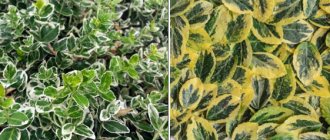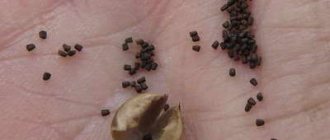Calicant: description of the bush
Calicanthus shrub: plant photo
The international name of Calicant is Calycanthus froridus. The plant can grow up to two to four meters, olive-colored shoots form a lush crown consisting of large green oval leaves, the length of which is ten to fifteen centimeters. Young leaves have fairly dense pubescence; over time, it remains only on the underside of the leaves, while the top becomes smooth and gray-green.
During the first two months of summer, large burgundy flowers bloom on the Calicantha bush, emitting a pleasant aroma. When the plant fades, medium-sized fruits similar to water lilies ripen on it, and there are seeds inside them. In autumn the leaves gradually turn yellow.
Varieties of the calicanthus plant
Flowering calicanthus, another name for Jamaican pepper. It grows up to three meters in height, has decomposed branches and brown shoots. Quite interesting and rare flowers of brown red color about five centimeters in diameter begin to bloom in June and early July. When the Jamaican pepper fades, a fruit appears similar to a water lily and approximately 7 cm in size. This plant can withstand frosts of up to 25 degrees.
Western calicanthus, decomposed, large branched bush, frost-resistant down to -23 degrees. The branches have an olive tint and the shoots are slightly pubescent. This species has the largest leaves up to 20 cm long and up to eight centimeters wide.
The prolific calicanthus is more winter-hardy. But it has a less fragrant flower scent. The leaves are similar in color to orchid flowers. Flowering for this variety begins in May. And some varieties differ from others in the shape and color of the leaves, which have a bluish, reddish hue.
Chinese calicanthus or pink jade is suitable for indoor growing. Its leaves are rich green, juicy, with fibers on the inside of the leaf. Pink jade has pinkish flowers with a pleasant aroma. Loves the sunny side of the apartment, does not like drafts. Prefers normally moist soil.
Calicant: outdoor care
Calicanthus grows well in our difficult climate and easily tolerates severe winter frosts. Like any plant, it needs special conditions, more about them.
Lighting
The plant loves good light, but at midday it is better for it to be in the shade. It is possible to plant calicanthus shrubs next to trees, but in this case you should choose neighbors with a fairly sparse crown so that the calicanthus gets the required amount of sunlight and is protected from direct sunlight.
Attention! Complete shade is a bad option for a shrub; it may not bloom.
Temperature
The calicanthus plant can take root well in both cold and warmer conditions. If you are planting a plant in the northern regions, you can plant it in the sun; in the south, it is better for the shrub to be in a more shady area.
The soil
Flowering calicanthus are unpretentious to the soil, but it is better to plant them in fertile soil. An important condition for the normal and proper growth of the shrub is the drainage layer, which will be at least twenty centimeters.
Watering
Calicanthus bushes require moderate watering; the soil should never become waterlogged. In hot weather, it is recommended to determine the intensity of watering by the rate of drying of the soil.
Humidity
It is necessary to mulch the ground around the plant to retain moisture; it is recommended to use peat, leaves and sawdust. This is necessary to protect the bush from drying out and water retention. On hot days, you should spray the leaves with treated water to prevent them from drying out and untimely yellowing.
Fertilizer
It is better to feed calicanthus with mineral or organic fertilizers in March.
Trimming
After replanting, it is recommended to carry out the first pruning. The calicanthus shrub likes to grow, but this makes its appearance less attractive. To avoid this, it is necessary to initially form a calicanth.
The next pruning is recommended after flowering. It is accompanied by the removal of damaged and dried branches and pinching of new shoots.
Wintering
Flowering Kalitantas are winter-hardy plants and tolerate temperatures down to minus thirty degrees. Despite this, gardeners recommend covering the shrubs with spruce branches; it will provide protection from precipitation and strong winds that can damage the plants.
Specifics of care
Calicanthus is a capricious plant for planting in open ground. The speed of growth and abundance of flowering directly depend on the quality of care. Growing Requirements:
- The plant is a moisture-loving plant; to maintain its decorative appearance and health, it is imperative to maintain constant soil moisture. To do this, the shrub is provided with watering regularly up to 2-3 times a week. During dry periods, it is recommended to spray with cool water;
- fertilizing is applied in the spring immediately after the start of active growing season and during the flowering period. It is advisable to use complex mineral compositions for flowering ornamental crops. Fertilizers are applied using the root method;
- Throughout the season, it is important to carry out sanitary and formative pruning, since leaves look untidy if not properly cared for. Calicanthus tolerates shaping well and is suitable for creating decorative compositions and hedges. The last pruning is carried out in the fall, during which all dry branches and inflorescences are removed, young shoots are pinched to accelerate growth for the next year;
- the plant has low frost resistance, so in late autumn after pruning it is important to prepare for winter. To do this, you should generously mulch the soil up to 7 cm thick and cover the plant with spruce branches or agrofibre.
Throughout the summer, it is advisable to regularly loosen the soil to increase its looseness and aeration. It is necessary to change the layer of mulch several times a season; it is more convenient to use sawdust or straw as a material.
Reproduction
Calicanthus shrub: plant photo
There are several possible ways to propagate Calicanthus. Let's look at each one.
Calicanthus from cuttings
It is better to separate cuttings simultaneously with sanitary pruning. You can use healthy and fairly young branches. The branches are cut using pruning shears and moved into a special solution “Kornevin”. After a day in the solution, the cuttings need to be planted in a greenhouse or ground and watered regularly so that they take root faster.
Calicanthus from seeds
Calicanthus seeds are scarified because the seeds are covered with a durable shell and it can be difficult for them to germinate. Seeds must be placed in warm water for two days, then sown in a substrate and germinate for two to five months at normal temperature. Afterwards the sprouts are transplanted into the ground. This method is rarely used due to the possibility of plants losing their floral aroma.
Need to know! With any vegetative propagation method, the plant will bloom only in the fourth year.
Calicanthus using layering
This is the easiest way. In early spring, holes are made near the root shoots, the shoots are carefully bent and secured in the hole made. The hole should not be less than five centimeters. You need to place a small stone on top as a load. Regular watering is important for layering. By the end of summer, the plant can already be transplanted to a permanent area.
Landing technology
In the Russian climate, Calicanthus is usually planted with grown seedlings in a container. It is best to purchase planting material from a special nursery or specialty store. Some gardeners grow plants from seeds, but this method is more complicated and does not always lead to a positive result. The optimal time for planting is early spring after reaching stable warm air and soil temperatures. Step-by-step algorithm:
- Dig the area thoroughly to the depth of a spade bayonet, remove stones and plant debris. Dig a hole 2 times larger than the container with the seedling.
- Place a layer of drainage up to 7 cm thick at the bottom of the planting hole; broken brick, expanded clay or pebbles are suitable as materials.
- Carefully remove the plant from the container and place it in the planting hole so that all roots are completely covered with soil. Supplement the remaining volume with a nutrient mixture of fertile soil and humus.
- Water the planting generously and mulch the entire area around the tree trunk.
If there is a possibility of night frosts in the near future, it is advisable to cover the plant with spruce branches or straw every evening. Calicanthus seedlings are most sensitive to low temperatures.
Calicanthus bush in landscape design
Calicanthus shrub: plant photo
A pleasant-smelling and attractive-looking shrub can decorate any summer cottage. Calicatnas can be planted individually or in a group with lavender, sage or wormwood. Such plants will not only be a visual decoration, but will also create a special atmosphere and a wonderful aroma. The still flowering plant looks beautiful against the backdrop of lawn grass. Regardless of the time of year, carefully planted calicanthus will delight the eyes of the owners.
The nuances of caring for shrubs and methods of propagation
Calicanthus is a moisture-loving plant, so it requires additional watering in the garden. This is especially true during the dry period of summer. Mulching is used to retain moisture in the soil. Hay, straw, stale sawdust, and fallen leaves are suitable here. In early spring, the bushes are fed with a complex of minerals. 20-30 g of fertilizer is enough for one plant. Annual pruning is a mandatory procedure. It is usually carried out in late autumn or early spring. At the same time, all dry and damaged branches are removed.
For the winter in the middle zone, the plant requires shelter. All shoots are carefully, one by one, bent to the ground. It is best to cover the top with agrotex and then with leaves or spruce branches. Next spring, not earlier than April, when you no longer have to wait for big frosts, the shelter is removed.
Advice. To make the bush wider, you need to pinch the tops several times a season.
Calicanthus grow slowly, but if you don’t want to get impenetrable jungle on your site, you should periodically remove the root growth. Calicanthus are propagated in traditional ways:
- seed;
- cuttings;
- layering.
When using the first method, there is a high probability that the plant will not retain its varietal qualities. Growing from cuttings allows you to obtain a very large number of plants at the same time. The fastest and easiest method is the last one. The branches are laid on the ground and pinned. By the next season, a completely independent plant is planted.
Planting calicanth and caring for it is not difficult. With a little patience and a minimum of effort, you can admire an incredibly beautiful plant in your own garden.
Pests and diseases
Calicanthus shrub: plant photo
Flowering calicanthus is resistant to both damaging factors. The only thing that can bother him is rotting roots. To prevent such a problem, you need to provide high-quality drainage and ensure proper watering of the plant.
Flowering calicanthus is a delightful and unpretentious plant with a pleasant aroma. In addition to its flowers, its leaves and carapace are also fragrant. Dried cara can be used as a flavoring agent. Calicanthus will help you create a pleasant atmosphere wherever it grows.
Varieties and types of calicanth with photos
The most common species in cultivation is the flowering calycanthus (Calycanthus floridus), about 1.5-2 meters high with shiny leaves. The flowers are burgundy or dark red, not very large (on average about 3-5 cm), reminiscent of magnolia flowers.
Calicanthus blooming
They are distinguished by a very strong fruity-spicy aroma, which can combine the smells of apples, strawberries, pineapple, cinnamon or cloves. On warm days, the smell is so strong that it can be felt already at a distance of several tens of meters.
In its homeland, the species was called “sweet bush”, and in Italy a line of perfume was developed with the trade name Calycanthus.
Deytsia - planting and care
It is best to buy seedlings of this species during the flowering period, since the intensity of the floral aroma and shades of its smell can vary widely. 'Athens' has pale yellow flowers that bloom in May with a sweet tropical fruit scent.
Variety "Athens"
The varietal series of this species “Purpureus” is characterized by slow growth and more abundant flowering. The main difference is the leaves - they are large, slightly wrinkled, purple-bronze. In autumn the bush turns orange-brown.
“Purpureus” series “Burgundy Spice” variety
Another species is the fertile calycanthus (Calycanthus fertilis) - a highly branched shrub about 2.5 meters in height. The flowers are red-violet or dark burgundy, up to 5 cm in diameter. Flowers of this species have no aroma. The varietal forms include o - a low-growing shrub with a height of just over a meter.
Calycanthus fertilis
Chinese calicant (Calycanthus chinensis) . Shrub with a dense, rounded crown. The flowers are odorless, white or pale pink with burgundy markings, and appear near the tips of the shoots in mid to late May. The Calicanthus variety “Pink Jade” is popular in culture.
Species diversity
The plant is just becoming popular in landscape design; only three main types are common for planting on the site. Description of calicanthus varieties:
- Flowering. The plant's homeland is North America, where the shrub forms large plantings and even impenetrable thickets. The height of the bush reaches 2.5 m, the growth rate is slow. The leaves are located opposite each other and are colored rich green. Flowering occurs in May and can last up to several months. Depending on the variety, they are colored yellow, red or red-brown;
- Prolific. The most winter-hardy plant variety. Flowers have a less pronounced aroma during budding. The leaves are long and pointed, the surface gloss is weak. Buds form in May, re-blooming is possible in June. The flowers are colored in purple shades;
- Chinese. It grows wild in China. The leaves have a pronounced gloss and pubescence on the lower part. In autumn they turn bright yellow. The flowers are large, pink or white. The most famous variety of this species is Pink Jade.
When choosing a variety to plant on your site, you should take into account stability, size and flowering characteristics. The plant is quite capricious, so it is advisable to purchase only resistant varieties.
Difficulties in growing
If you follow all the recommendations for planting and caring for flowering shrubs, then the likelihood of any problems arising is minimal.
Excess and lack of moisture, as well as weather conditions - for example, strong wind or scorching sun - have a detrimental effect on the plant. In such cases, gardeners recommend providing protection for the calicanthus - accordingly, shading it and protecting it from the wind.
Otherwise, this plant is unpretentious and will not cause much trouble.
How to plant a fragrant shrub
The best time to purchase seedlings is spring. Moreover, you should buy them in containers. This way the delicate roots are minimally damaged during transplantation. A well-lit place for planting calicanthus is required. Protection from draft winds in the form of a building or dense bush is required. Planting calicanth on the site occurs as follows:
- Prepare the hole. Its size should be 2 times larger than the earthen ball in the container.
- The soil is mixed with compost. This will loosen it well and serve as fertilizer.
- Carefully remove the calicant from the container and place it in the hole. The planting depth should correspond to the level of the earthen ball held on the seedling.
- Add soil from all sides. To prevent water from running away during irrigation, a circle around the trunk is formed.
- They moisten the soil well.
After completing the described work, the soil next to the bush is sprinkled with mulch. It is very good to use straw or hay for this purpose.
Advice. In order for the calicanthus to feel good and, accordingly, more buds form on it, you can add a little lime to the soil.











